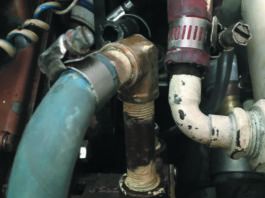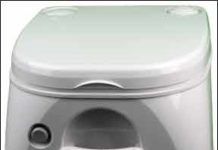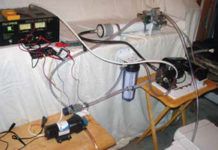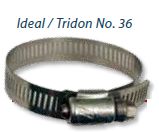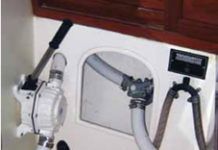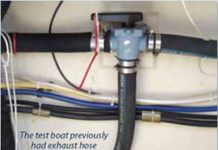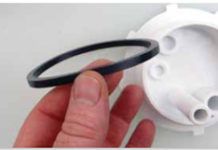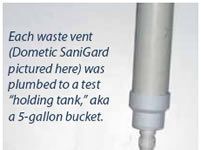Portable Marine Toilets for Small Boats
A few steps above the old cedar bucket, portable marine toilets are essentially glorified waste containers, but a good one offers more comfort than a bucket, wont leak, and can be emptied and cleaned with limited hassle. We tested three porta potties made by Thetford-the Porta Potti 260, the Porta Potti 550P, and the Porta Potti Curve-and two West Marine-brand port potties made by Dometic/SeaLand, the Runabout 962 and the Cruiser 976. Testers rated performance, features, and construction quality.
DC Watermakers Head-to-head Test
Reverse-osmosis, DC-powered watermakers have been available for use aboard mid-sized cruising sailboats for years, but thanks to new technology, they just keep getting better. Todays units are more efficient, reasonably compact, and in many cases, modular in design. Practical Sailor recently tested two popular models-new Ventura 200T from Spectra Watermakers Inc. and Racor Village Marines Little Wonder (LWM-145)-and rated them for water and construction quality, noise, power consumption, and ease of installation and maintenance. The review also discusses the pros/cons of installing a watermaker on a sailboat, installation and maintenance tips, and whether a watermaker is right for you.
Stainless-steel Hose Clamps
Practical Sailor evaluated stainless-steel hose clamps from 11 manufacturers, including Shields, ABA, Murray, AWAB, Breeze, American Valve, Ideal/Tridon, Trident, Koehler, and Norton. The test clamps, both T-bolt and worm-drive designs, were all size 28 (for hose sizes 1 5/16 to 2 1/4 inches) and 32 (for hoses 1 1/2 to 2 1/4 inches). Bench tests included torque to compression and torque to failure tests, and a magnet test and long-term saltwater bath test to determine corrosion resistance. All clamps were closely examined for quality of construction and workmanship, and price was considered in final ratings.
Y-valve Installation Advice and Troubleshooting
All waste plumbing hoses should be kept as short and straight as possible with no dips where waste could collect. The diverter valve should be located for easy access to the selector handle and free of other stored “stuff” that could bump the handle. The handle positions should be clearly marked for no confusion as to tank or overboard. Before mounting, make sure there is enough room for all three hose fittings and hose bends. Use 120- or 90-degree hose fittings where necessary to prevent tight bends in discharge hoses, and make sure to use the correct reinforced hose designed for sanitation systems.
Y-valves Under Pressure
Continuing with our most recent evaluations of marine sanitation systems, Practical Sailor tested eight marine-grade diverter valves (Y-valves), the valves that control the flow of liquid from one source to two different outlets or from two sources to one outlet. The test field comprised seven manual diverter valves and one electric valve from seven manufacturers. Testers looked at construction, performance, ease of use and install, price, and warranty. The manual Y-valves tested included products from Bosworth Co., Jabsco, Forespar, Groco, Johnson, Whale, and Trudesign (distributed in the U.S. by Raritan). Testers also looked at an electric Y-valve from Trudesign.
Marine Sanitation Hose Test
Sanitation hoses are specifically designed to contain odorous gases. They are made of very different materials than the many similar-looking hoses used for fuel, coolant, and potable water—and they are not interchangeable. In a home, sewage is contained by rigid metal and PVC pipes, materials that are not practical on a boat. So what are the best hoses to use in an onboard waste system? Practical Sailor tested hoses made of butyl rubber, white vinyl, and polyurethane from Raritan, SeaLand, Shields Marine, and Trident to find. This report covers the test results at the one-year mark.
Installing Hoses Highlights Their Differences
While model holding-tank testing allows side-by-side comparisons, there’s nothing like on-the-boat testing to sort out practical differences. Our test boat, a PDQ 32, had been plumbed with a mix of low-end vinyl sanitation hose and water exhaust hose; the rubber hose was permeated, cracked, and discolored, and the sanitation hose was permeated to the point of having a thin film of sticky goo that had condensed on the external surface. A textbook case of time showing the weaknesses of poor material selection.
Holding Tank Test Followup
Practical Sailor recently tested an updated version of the SeaLand 20 HTS-VRT holding tank reviewed in our November 2011 test, which found the Trionic SP-2020 super premium holding tank to be the Best Choice. For this test followup, SeaLand sent us a tank with the inlet and outlet fittings firmly installed and sealed with pipe sealant, as the maker recommends. (Aftermarket tanks are typically shipped with fittings separate.) The re-test found the revised SeaLand to be leak free, but the Trionic is less expensive and showed less deflection.
Finding Good Hose Clamps
In the December 2011 article, “Maintaining Stainless Steel,” you mention that there are hose-clamp makers that get the stainless-steel combination right, but never shared who those manufacturers might be. I’d love to know who’s your pick!
Test Setup Simulates Onboard Sewage System
To create a real-world test, we assembled a series of miniature holding tanks containing sanitary waste generously supplied by a 20-pound, 5-foot pet iguana named Ziggy. This was supplemented with other sanitary waste as needed. Seawater flush was used because saltwater is known to contribute to odor.



































